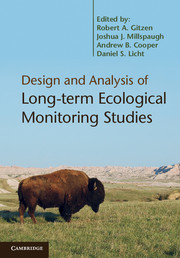Book contents
- Frontmatter
- Contents
- List of contributors
- Foreword: Ecology, management, and monitoring
- Preface
- Acknowledgments
- Abbreviations
- Section I Overview
- Section II Survey design
- Section III Data analysis
- Section IV Advanced issues and applications
- Section V Conclusion
- 22 Institutionalizing an effective long-term monitoring program in the US National Park Service
- 23 Choosing among long-term ecological monitoring programs and knowing when to stop
- References
- Index
- Plate Section
22 - Institutionalizing an effective long-term monitoring program in the US National Park Service
Published online by Cambridge University Press: 05 July 2012
- Frontmatter
- Contents
- List of contributors
- Foreword: Ecology, management, and monitoring
- Preface
- Acknowledgments
- Abbreviations
- Section I Overview
- Section II Survey design
- Section III Data analysis
- Section IV Advanced issues and applications
- Section V Conclusion
- 22 Institutionalizing an effective long-term monitoring program in the US National Park Service
- 23 Choosing among long-term ecological monitoring programs and knowing when to stop
- References
- Index
- Plate Section
Summary
Introduction
The need for long-term ecological monitoring
Managers of protected areas have increasingly recognized the value and need for credible, scientific information as a basis for making management decisions and working with partners and the public to conserve natural resources. The management of natural resources has become increasingly complex, both technically and politically. Managers need reliable data and information on the status and trends in the condition of key resources that they manage as a basis for conservation planning, determining whether current management practices are having the desired effect, and informing stakeholders and the general public of changes in the condition of natural resources that may be caused by stressors operating at regional or global scales.
Long-term ecological monitoring provides information needed to understand and identify change in natural systems characterized by complexity, variability, and surprises. This information can be used to assess whether observed changes are within natural levels of variability or may be the result of unwanted human influences. Data collected in a consistent way over long periods are fundamental to conservation and management because they provide the context for interpreting observed changes, and may provide the basis for initiating new management practices or changing existing practices (Carpenter 1998, Lovett et al. 2007). For example, reliable and consistently collected data from long-term studies are currently in high demand for developing quantitative models to inform conservation and action plans for addressing the ecological consequences of rapid climate change.
- Type
- Chapter
- Information
- Design and Analysis of Long-term Ecological Monitoring Studies , pp. 481 - 497Publisher: Cambridge University PressPrint publication year: 2012
- 41
- Cited by

